Historic Review on the ES Computers Family
Home → Articles → Historic Review on the ES Computers Family. Part two.
by Victor V. Przhijalkovskiy
translated by Alexander Nitussov
Part two – until 1983
In June 1973 international trade exhibition “ЕС ЭВМ-73” (ES Computers 73) took place in Moscow. It summarized results of the first stage of the ES project work, clearly demonstrating high potential of the socialist countries' joint efforts.
In the USSR, ES project enjoyed special attention from the State Planning Committee, military industrial committee of the USSR Council of Ministers, State Committee on Science and Technologies (SCST) and the Ministry of Radio Industry (MRI). This attention was supported with substantial investments, among them – construction of four new computer plants began in the Ukraine, extension and modernization of computer plants in Minsk and Kazan, etc. New building for SIDEC was quickly constructed in Moscow and new equipment was purchased. This work was conducted by “the eighth directorate general” of the MRI and was headed by its deputy-minister N.V. Gorshkov.
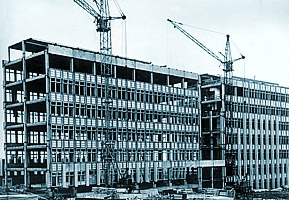
Construction of the laboratory building for SIDEC, 1972.
At the same time one have to admit that already in the beginning of the ES Computers production some problems emerged that accompanied Soviet computing all following years.
Thus, development of the basic microelectronic components for computer industry progressed in parallel with them, not outstripping its pace of growth. Whereas design of an average computer lasted not less than three years, by the time of its supply to a customer its main components became out-dated.
Before the 1980-s the rate of integration in the Soviet microcircuits was steadily growing. However, in reality it looked so, that, e.g., in the model ES-1020 only eight types of microcircuits (series 155 – lower integration rate) were implemented, but by the beginning of its manufacturing twenty more types appeared, already of the medium integration rate, but they were not used in the computer.
Secondly, the chemical industry could not maintain stable production of special plastics for germetizing the microcircuits' cases (or, may be, was not interested?). As the result of that, reliability of microcircuits was very low. Especially many failures occurred in the computer cabinets in the artificial ventilation conditions.
There were many problems with production of high-quality components for ferromagnetic-based varnishes for magnetic storage on replaceable magnetic disks. Available amount of them was always insufficient, neither were there precision bearings in needed amount, high-quality rolled metal baseplates for magnetic disks, magnetic tape for high-density recording and precession step-motors for external storage and other peripheral devices.
Also negative effect (on the author's opinion) was caused by the categorical demand of the Ministry of Defence, to all ES Computers hardware, to be able to withstand the blast loads (impact loads) not less than 15g along all axes. Fulfilling of this requirement led to unreasonably excessive weight of hardware and increasing of their costs.
However, additional choice of the microcircuits, which appeared by the finishing of ES Computers-1 development, new generation of peripheral memory devices with higher speed, as well as increasing experience and qualification of designers created conditions for essential modernization of the ES Computers-1 developed in the first of the project.
The task of modernization of ES Computers-1, in fact the next – the second part of the project, was given to Special Design Bureaus; participations of scientific-research institutes should be minimal.
Modernized computers received numbers (correspondingly) ES-1022, ES-1033, ES-1055 (ЕС-1022, ЕС-1033 , ЕС-1052). Their architecture basically was similar to ES Computers-1, modernization was performed only on some concrete structures and their hardware realization. Development of ES-1022 was headed by I.K. Rostovtsev – chief engineer of the Minsk G.K. Ordzhonikidze computer plant. V.F. Gusev – chief of the Special Design Bureau (SDB) of Kazan[1] computer plant headed creation of ES-1033. ES-1052 was designed by the team of V.S. Antonov, at the SDB of Penza computer plant and SIDEC.
However, the beginning of the ES Computers-1 modernization started with the model ES-1032 developed by Boleslaw Pivowar's team in Wroсlaw (Poland) at the SDB of ELWRO computer plant.
Main characteristics of the modernized ES computers are given below.
Model |
ЕS-1022 |
ЕS-1032 |
ЕS-1033 |
ЕS-1052 |
Completion of development |
1975 |
1974 |
1976 |
1978 |
Bit grid of double bits |
16 |
32 |
32 |
64 |
Performance, thous. ops |
80 |
180 |
200 |
700 |
RAM capacity, Kb |
128–256 |
128–1024 |
256–512 |
1024 |
RAM cycle, ms- |
2 |
1,2 |
1,2 |
1,25 |
Number of selector channels |
2 |
3 |
3 |
4 |
Speed of selector channels Kb/sec |
500 |
1100 |
800 |
1300 |
Type of integrated circuits |
Series 155 (ТТL) |
SN-74 |
Series 155, special circuits |
Series 137, 138 |
Operating system |
DOS, ОS |
DOS, ОS |
DOS, ОS |
ОS |
Power supply, kVA |
25 |
23 |
40 |
60 |
Required space, sqm |
108 |
80 |
120 |
230 |
The models ES-1032 had much more advanced technical and economical characteristics. As the architecture of all ES computers was unified, the reason for that success could be only the components' quality.
It makes sense to clear the point here, because appearance of Polish ES-1032 initiated in the USSR fierce debates among the supreme bodies of power (State Planning Commission, State Committee on Science and Technologies, Military and Industry Complex, Ministry of Radio Industry). Processor unit of ES-1032 together with RAM and the channels mere assembled in one cabinet, while the Soviet ES-1022 and ES-1033 needed three cabinets for the same purpose. Development of the computer was independently performed at the Wroclaw computer plants outside the ES Computers Council of Chief Designer's programs.
After its completion there emerged the problem with its integration into ES series and assigning it appropriate serial code number. When technical documents of ES-1032 were studied it turned out that its design did not fully correspond to basic documents and standards of the ES Computers project.
Main “violation of rules” consisted in usage of full series of the microcircuits SN-74 from “the Texas Instruments Inc.” The Soviet analogue of this series – series 155 (“Logica-2”) had two times worse characteristics and lacked circuits of increased integration. According to the strict demands (even pressure) from Military industry and the Ministry of Defence usage of foreign components, which had no Soviet analogues, was absolutely forbidden. Same was with power supply units. Implementation of doubled Standard Card Modules (SCM) or Line Replaceable Units (LRU) with dimensions 280x150 mm, was equally violation of accepted ES regulations. All that and also usage of multilayered LRU printed board and implementation of semiconductor memory instead of ferrite core one (then, in the USSR, microcircuits for RAM were not yet in serial production) permitted Polish designers essentially reduce size of the computer and the required power supply.
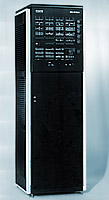
Processor unit ES-1032
As a result of intensive debates on supreme level computer ES-1032 was included in the ES Computers system and many documents for ES Computers were corrected. Unfortunately the technical level of Soviet microcomponents permanently lagged behind the foreign analogues in increasing tempo. Computer ES-1032 was not imported in the USSR however the role it played in initiating of the ES-1022 and ES-1033 projects (the most popular of all ES computers) was the most positive. It clearly demonstrated decisive influence of the components and technologies on operational characteristics of computers.
Unfortunately this “lesson” was not properly understood and, in the USSR, problems of computer architecture were still discussed much more often than technological questions of microelectronics, common for all architectures.
Modernization of ES Computers-1 and debates on the ES-1032 were conducted in 1973-1974 simultaneously with the works on the system ES Computers-2.
The first discussion on the new computer line, named ES Computers-2 (Ryad-2), was discussed at the meeting of chief designers from the East European countries, project-participants, on 27 July 1972. The chief designer A.M. Larionov was its chairman. The Council of Chief Designers (CCD) developed that program and, in 1973, the Soviet part of it (computers and other devices) was adopted by the USSR Government. In April 1974 it was adopted by the 13th session of the CCD. The ES Computers-1 modernization program was also adopted there. By that time Cuba (1973) and Rumania (1974) also joined the project works.
Oppositely to the ES Computers-1 development, the ES Computers-2 program was fully composed upon the unified ES Computers standards, without consideration of some countries-participants' earlier technical orientation.
The tasks for the second work stage of the ES development, given by the CCD to the scientific experts and designers of all countries, were the following:
- improvement of the performance-costs efficiency indexes for computers of each class;
- further development of the processors' logic structure at full programming (software) compatibility with the IBM-370 system;
- extension of RAM capacity for all models and implementation of its virtual organization;
- extension of machine-instruction codes, increasing of computation precision;
- development of new set of peripheral devices and external storages;
- essential increasing of the control and diagnostics means operation efficiency;
- creation of real possibilities for development of dual-processor and multi-computer systems.
The program of the second ES Computers development stage consisted of seven computer models and about 150 types of peripheral devices. Four models and thirty types of peripheral devices were developed in the USSR.
In 1975-1976 administration of the USSR Ministry of Radio Industry (MRI) and SIDEC received business-representatives of the IBM corporation. At first IBM demonstrated interest to cooperation with the MRI. Although, at that time IBM had no plans of selling something essential to the USSR, emerging new market of IBM-compatible hard- and soft-ware attracted its positive interest. That was the time when the IBM-370 compatible computer companies “Amdal”, “Fujitsu” and “Hitachi” started their production. Those companies had made the same decision as the Soviet MRI earlier, in 1967-68. However, the IBM Corp. failed to receive approval of the USA government for cooperation with the MRI. The talks between the interested sides were slow, and in 1979, after the beginning of Afghan war were concealed. Nevertheless, by the end of 1978 the program of ES Computers-2 development was practically completed. During the 1976-1978 the joint testing of new hard- and soft-ware, by governmental commissions, was performed. New models: ES-1025 (Hungary), ES-1035 (USSR), ES-1055 (GDR), and ES-1060 (USSR) were successfully released on the market. At the same time there were delays in development of ES-1015 (Hungary) and ES-1065 (USSR).
Main characteristics of the ES computers, as tested by the end of 1978, are given below.
Model |
ЕS-1025 |
ЕS-1035 |
ЕS1045 |
ЕS-1055 |
ЕS-1060 |
Completion of development |
1978 |
1977 |
1978 |
1978 |
1977 |
Bit grid of double bits |
16 |
32 |
32 |
64 |
64 |
Performance (thous. ops by Gibson-3) |
33 |
160 |
660 |
425 |
1050 |
RAM capacity, Mb |
0,256 |
0,256–1,0 |
1–4 |
1–2 |
1–8 |
RAM cycle, ms |
|
1,2 |
1,2 |
1,14 |
1,2 |
Number of block-multiplexed channels |
- |
2 |
5 |
4 |
до 6 |
Total throughput of the cannels, Mb/sec |
0,4 |
1,2 |
5 |
5 |
9 |
Type of integrated circuits |
TTL-S |
IS (ИС)-500 |
IS-500 |
TTL-S |
IS-500 |
Operating system |
DOS-3.1 |
DOS-2, ОС-6.1 |
OS-6.1 |
OS-6.1 |
OS-6.1 |
Overall power supply kVA |
10 |
40 |
35 |
35 |
80 |
Required space, sqm |
75 |
110 |
120 |
150 |
200 |
Soviet models ES-1035 (Chief designer G.D. Smirnov), ES-1045 (chief designer A.T. Kuchukyan) and ES-1060 (chief designer V.S. Antonov) soon became the main item of the Minsk and Kazan computer plants production.
Two new original OS systems were developed for ES Computers-2: DOS-3.1 and OS-6.1.
Operating system DOS-3.1 was worked-out by specialists of Czechoslovakia and Hungary. It was absolutely original system, which enabled virtual addressing with preserving files compatibility with DOS-2 and OS ES systems. In comparison with its previous version operating system OS-6.1 obtained the following extensions: virtual memory mode, operation with 100 Mbyte and display complex ES-7920, restoration and diagnostics means, complexing computing facilities, time sharing system including dialogue programming system, optimizing translator from language PL-1 and a monitor for dynamic debugging. Besides that the customer (user) received set of applied programs packages operating under control of OS-6.1.
In June 1979 a joint exposition of TS hard- and-software took place at the central exhibition site in Moscow. It was named “ES Computers and SM Computers and their applications”. The presented exposition summarized the achievements of the completed program ES Computers-2. Six computers and more than 70 external storage and other devices, designed according to the program ES Computers-2, were displayed there. The disk storage units ES-5066 (USSR) and ES 5067 (Bulgaria), with capacity about 100 and 200 Mbyte respectably, magnetic tape memory ES-5025 (USSR), ES-5612 (Bulgaria) and ES-5002 (GDR) with density 126 and 192 impulses/mm were the latest achievements and were publicly displayed for the first time.
Among other new devises the matrix processor from Bulgaria, two types of telecommunication processors and data transmission multiplexer, display stations 7920 (USSR) and 7910 (Poland) as well as numerous data and communication terminals also attracted increased attention of the experts and visitors. Many regional centres of technical maintenance service of the All-Union corporation Soyuz-EVM-Complex, established during previous 4-5 years, also demonstrated their technical achievements.
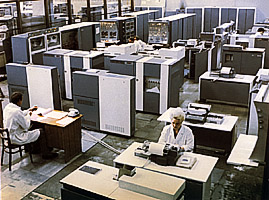
Testing unit work shop of the Moscow Industrial Corporation on Computing Machinery.
ES Computers-2 essentially icreased technological quality-level of plants. The Europe's biggest printed boards manufacturing plant was constructed in Minsk. It produced a year, a million of eight-layers boards for Line Replaceable Units and hundred thousands more counter panels, size 500 x 500 mm. The plant was built together with French company SII. Its price equaled 55 million US Dollars (state 1978). The plant provided printed boards for all ES Computers program.
Other plants were constructed in towns Minsk and Brest (Byelorussia), Kazan (rep. of Tatarstan RF), Penza, Volzhskiy and Astrachan (Russia, RF), Bojarka, Kanev, Vinnitsa and Kamenetsk-Podolskiy (Ukraine).
Thus, a powerful branch of the national economy was established and successfully developed under general administration by N.V. Gorshkov – the USSR minister of radio industry. Alongside with the ES program, computers BESM-6, mobile computing stations for defence purposes, on-board space and aircraft computers, for anti-missile defence stations, army, etc.
The exhibition of 1979 displayed the scales of ES Computers implementation in the national economy. At that time computers ES made about 72% of the total amount of Soviet computers. Six models of ES and 42 types of peripheral devices were in stable production. Only within the period 1975 till 1979 more 700 automated systems and complexes of various levels were created being entirely based on ES Computers hardware. The biggest systems were installed at the administrative offices and other organizational of the Central Statistics Directorate, State Committee on Science and Technologies, State Standardization Directorate, State Planning Committee (Gossnab), State Supply Committee and many other organizations. ES computers were widely used at the research institutes of the USSR Academy of Sciences and universities.
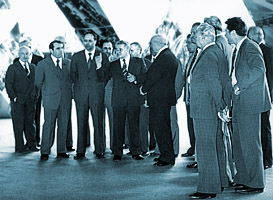
The USSR governmental officials at the 1979 exhibition „ES Computers and SM Computers“.
According to the author's opinion the ES computers became so popular for the following reasons:
- ES computers offered the users efficient technical and programming possibilities, which made possible creation of automatic control systems, ranging from the smallest ones up to the systems of strategic scales;
- from its very beginning the ES program offered the users unprecedented for its possibilities, quantity and volume amount of software: progressive programming system (6 programming languages) and operating systems (DOS and OS) compatible with many other popular in the world systems (then, about 85% of all universal computers in the West implemented architecture IBM-370);
- in the process of the ES computers development the system of complex centralized technical maintenance of these machines which included teaching of personnel, testing and warranty services was created in the USSR.
During the 1978-1981 period, main direction of the ES-1035, ES-1045 and ES-1060 computers modernization consisted in replacing ferrite memory with the semiconductor one. As new microcircuits (4 kbit, 16 kbit, 64 kbit, mounted in case) for dynamic semiconductor memory were put into serial production they were immediately implemented into new RAM units.
Modernization of the model ES-1060 occupied a special place in the general program of ES Computers-2 development. That was performed by specialists of the Minsk Manufacturing Group „Computing Machinery“ (MMG CM) and the Minsk affiliate of SIDEC under general guidance by Y.V. Karpilovich – the chief engineer of MMG CM. As the result, not only ES-1060's RAM units were modernizsd but also the processor and channels. The improved model ES-1061 had double performance and three times higher reliability level, its sizes were essentially reduced as well as its power supply needs and costs.
Especially important contribution was made by the chief of Special Design Bureau of the MMG CM V.P. Shershen. He and his team successfully performed the work on increasing reliability of microcircuits produced by other electronic enterprises. Completion of computer ES-1061 was a big success. This “Minsk model” was in big demand on computer market; 566 machines were sold in the period from 1983 till 1988. For comparison, computers BESM-6 were produced from 1967-1983; 454 were sold in that period (although, at the time of its appearance on market, BESM-6, designed by S.A. Lebedev, was one of the world's best ones -if not the best- its software was not compatible with most of other computers, it was more “scientifically oriented” and it the late 1970s its components were already old-fashioned //editor's note).
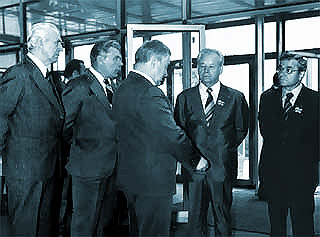
The USSR government members at the 1979 exhibition “ES Computers and SM Computers”
Another direction of the ES Computers-2 development was creation of the matrix processors, both built-in variants for ES-1045 and ES-1055 and autonomous models, compatible with all ES computers.
By the beginning of the 1980s ES computers practically satisfied needs in universal computers in the countries of the Eastern European community. However, demand for small computers which had performance lower than the lowest model from the ES line. Also there remained the need in supercomputers which were not included in the ES Computers program.
In 1974 the intergovernmental commission on computer development extended the range of its activity including small computers in its plans. The special Council of Chief Designers (CCD) was established for development of the small computers line (SM Computers – Seriya Malykh EVM). As the basic prototype for it the CCD adopted architecture of PDP-11 computers of the DEC Co. The reasons of such decision were the same as by the adoption of IBM-360 architecture for the ES series.
B.N. Naumov (Наумов Б.Н.) – the director of the Scientific-research Institute of Control Computers (SICC) and academician of the AS USSR was appointed as the scientific head of that project. The line of supercomputers was still developed (rather independently of these programs) as the supercomputers ELBRUS series, by the Institute of Precession Mechanics and Computer Machinery under its new director academician V.S. Burtsev[2]).
During the joint work of the countries-partners on the ES Computers-2 program several weak points and unsolved problems emerged which were neither solved not improved practically until the end of the cooperation. Thus complete specialization and distribution of functions was not reached despite the permanent ordering and arrangement of the hard-and-software assortment.
The organizational problems of joint task forces at common design, development, etc. were also not solved. The work was in a good progress when the project could be divided into several independent segments, which were distributed among different groups (in different countries) but the efforts of organization “physically” joint teams (from several countries) working in the same place were mainly a failure[3].
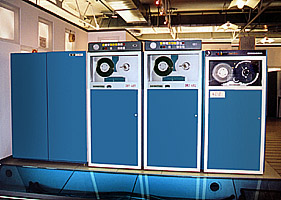
Magnetic tape storage ES-5017
Because of uncoordinated currency exchange rates prices for some concrete mutual deliveries were nominated only after long debates and sometimes even after indirect (or direct) “pressure” of the Soviet authorities. For that reason interest of some countries-participants began to decrease by the 1980s.
Nevertheless, the volume of mutual deliveries of the ES production was steadily growing from year to year. Thus, Bulgaria supplied the partners with ES-1020 and ES-1022, with magnetic memory storage devices on magnetic tape and disks, sometime later it produced and sold matrix processors.
Hungary provided computers ES-1010, 1012 and ES-1015 and the means for data remote processing, GDR – ES-1045 and ES-1055 and the magnetic tape storage ES-5017.
Poland produced and sold big amounts of alpha-numeric printers ES-7033, Czechoslovakia – photo-scanning mechanisms and console typewriter.
The data on the Soviet (Ministry of Radio-Industry), 1971-1979, export to the partner-countries are given below in the table:
Model of computer |
1971–1975 |
1976–1979 |
1971–1979 |
"Minsk-32" |
39 |
- |
39 |
BESM-6 |
2 |
- |
2 |
ES-1020 |
118 |
- |
118 |
ES-1022 |
- |
154 |
154 |
ES-1030 |
79 |
23 |
102 |
ES-1033 |
- |
53 |
53 |
ES-1050 |
- |
1 |
1 |
Total |
238 |
231 |
469 |
Punch cards input devices ES-6019 and tape controller ES-5517 were exported to the partners in comparatively big amounts.
In the end of the 1070s the CCD conducted preparation works on planning the third period of the ES Computers development program, for the period from1980 till1985 (in the USSR – the time of the 11th Five Years plan of national economic development). The CCD's experts studied development tendencies of scientific, technological and production potential of all participants, also the tendencies of production and implementation of universal (civic) computers progress, and the plans of microelectronic industry development.
It was confirmed that by 1985 the 10-years operation period of about 5500 universal computers, including computers URAL-11, -14, -16 (325 computers), BESM-4 and BESM-4m (441 comp.), M-220 and M222 (502 comp.).
According to the expert estimation it was expected that 195 computers BESM-6, of then available 355, would be taken out of operation. Finishing of 2889 computers MINSK-32 operation at the scientific organizations and enterprises of national economy was a notable factor of principle changes in the structure of universal computers supply.
Therefore, computers ES should be eventually form almost 100% of all computers engaged in solving scientific, economic, social and other civic problems. The total cost of all those computers was predicted to reach the level of 16 milliards US dollars (with currency/prices rate of that time).
The estimated costs (prognosed) of the users' applied software, would make about 10-12 milliards US dollars. All that was the reason for development of the ES Computers-3 software compatible with computers of the ES-2 and ES-1 series on the users programming level.
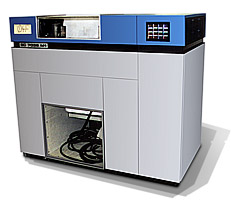
Alphanumeric printer ES 7038
The problem of compatibility with foreign (western) IBM-370 architecture based computers was also analyzed. According to the available foreign data 85% of the civil users worked with this architecture, and its development were in a constant progress. Total cost of its applied software, which was in common use at the moment, equaled 200 milliards US dollars.
It was acknowledged that compatibility with this architecture could -and should- be maintained, despite ad additional investments and efforts. Preserving the software compatibility with IBM-370 on the level of user programs, large packages of applied programs (IMS, IDMS, CICS, ADABAS, etc.) and OS, was possible only on basis of the already designed ES structure and circuitry.
Oppositely to the matrix processors ES computers-2, the problem orientation should be realized with the use of special processors which had their own RAM and were connected to the input-output interface.
The longest discussions at the CCD and in SIDEC were held on the issues of large-scale integrated circuits choice. The variants of their implementation in memory devices were clear and undisputable but the problem of computer logic structures design on their basis caused collision of expert's opposing opinions. The enterprises of electronic industry branch long time objected against manufacturing the large-scale integrated circuits. Under conditions of economic mechanism of that time they could not receive any profit from production of several hundreds of those circuits types with only small amounts of each of them (in manufactured series). The proposed (by them) alternative project consisted in creation of the computer based on microprocessors of only one or few types, in which microprograms could be set for performing necessary functions of each (type of) logic circuits and each unit of a big computer.
By the end of the 1970s computer design based on matrix large-scale integrated circuits was tested on computers produced by companies “Amdahl Corp.” and “Fujitsu”. From 1976 they produced high-performance computers with matrix large-scale integrated circuits, with 100 logic gates per a crystal. IBM Co. did not have such computers that time, but already made prognoses on releasing them in the nearest future.
Therefore, in fact, the USSR electronic producing industry obviously avoided manufacturing of the matrix large-scale integrated circuits, and the compatibility neither with IBM nor even with the ES Computers-2 in such conditions, and in case of new microprocessors implementation in the already existing computer structures, would be unreachable. The only -then- realistic solution consisted in dividing the ES Computers-3 project performance into two periods. Thus, the first line of soviet computers ES-1036, 1046 and ES-1066 should be made with the most modern microcircuits of medium integration rate -IS series, but the other part – ES-1037, ES-1047 and ES-1067 should be based on the matrix circuits, which would be produced by industry by the beginning of those computers design works. Unfortunately, that solution also “programmed” increasing technological inferiority in comparison with the western computers and, subsequently, inevitably to the inferiority in architecture. However, then in 1977-1978, designers and administration could see no other solution of the problem.
The first order of ES-3 computers appeared by the mid-1984. The soviet computers ES-1036, ES-1046 and ES-1066 ( ЕС-1036, -1046 and -1066) were designed by the Scientific-research Institute of Computing Machinery (chief designer Dr. R.M. Astsaturov), Erevan Institute of Mathematic Machines (chief designer Dr. A.T. Kuchukjan) and SIDEC (chief designer Dr. Y.S. Lomov). Hungarian ES-1016 and Czechoslovakian ES-1026 were not imported by the USSR. The lowest-grade computer in the USSR was ES-1036. The market of lower performance computers was supplied with SM computers. The supercomputers (ELBRUS) were developed, as usual, by the IPM-and-CM.
The program adopted by the USSR government commission also included plans of computer range production extension and improvement of the peripheral equipment characteristics. At the same time there were serious problems with production of magnetic disk and tape memory devices, terminal stations and the remote processing means, in the USSR. Technical and operation characteristics of the storage were inferior to the foreign analogues. Nevertheless, completion of the ES Computers-3 program resulted in bringing to market magnetic disks storage units with capacity 200 and 317 Mbyte, the latter were made on Winchester technology. Also appeared magnetic tape storage devices with recording density – 127 pulses/mm. Besides that there were designed: matrix processor, programmable processors for remote data processing (three types), new terminal stations and input-output devices.
Main characteristics of the ES Computers-3 are given below.
Model |
ЕS-1016 |
ЕS-1026 |
ЕS-1036 |
ЕS-1046 |
ЕS-1066 |
Completion of development |
1984 |
1984 |
1983 |
1984 |
1984 |
Bit grid, bit |
16 |
16 |
32 |
32 |
64 |
Performance, ops |
18-22 thousand |
50-100 housand |
400 th. |
1,3 Mio |
5,5 Mio |
RAM capacity, Mb |
0,512 |
0.256–0,512 |
2–4 |
4–8 |
8–16 |
RAM cycle, msec |
1,1 |
1,0 |
1,1 |
1,0 |
0,64 |
Number of block-multiplexed cannels |
Integrated adapter |
Built-in integrated adapter |
2–4 |
4 |
10 |
Total throughput of the channels, Mb/sec |
0,160 |
0,8 |
4,5 |
9 |
18 |
Type of integrated circuits |
TTL |
ТТL |
IS-500 |
IS-500 |
IS-500 |
Operating system |
DOS-3 |
DOS-3 |
ОS-7 |
ОS-7 |
ОS-7 |
Required space, sqm |
35 |
50 |
60 |
80 |
120 |
Power supply kVA |
7 |
10 |
35 |
40 |
50 |
Computers ES-3 possessed original operating system OS-7 which consisted of the system of virtual computers (SVC) and basic operating system (BOS).
The first of SVC was produced at the Institute of electronic computers in 1981. The system provided each user with computation resources as in a virtual computer with memory volume of 16 Mb. The users could work with various OS in a „visitor mode“. The basic OS efficiently provided and maintained compatibility with previous operating systems of the ES computers. OS-7 was successful on the market until the beginning of the 1990s. However, many ES users, first of all governmental organizations, used original operating systems of IBM – VM and MVS.
Successful creation and releasing of ES operating systems was announced and the authoring team prized as early as in 1978. The USSR State Premium was given to the authors of DOS and OS: Prof. M.R. Shura-Bura and also L.D. Raikov, K.A. Larionov, Ya.S. Shegedevich, G.V.Peledov (SIDEC), A.H. Abdurakhmanov (Kazan computer plant), E.V. Kovalevich, L.T. Chuprigina (Institute of Electronic Computers), A.I. Garo.
Computers of the series ES-3 were the most advanced. The research and development teams were already well-formed and experienced. Many, well equipped, computer plants with high-qualified personnel produced broad range of various devices. The yearly volume of that industry's production coasted several milliards Roubles (in the later 1980s). Vice-minister of the Ministry of Radio Industry N.V. Gorshkov was its chief-manager since 1967. The computer market was eventually filled with necessary production. From 800 up to 1200 various computers appeared on the market each year. 20% of them were given to the Ministry of Defence, and many foreign countries permanently imported those machines. Among them were: the East-European countries, India, Viet-Nam, China, Cuba, countries of the Near East, etc.
In April 1983 was released the special directive of the USSR government, supported by the Ministry of Defence and many other leading industrial Ministries of the USSR. According to it numerous organizations, enterprises, institutes, task-forces, and also -personally- many scientists, engineers, technicians and workers were given the state awards for: „Development and organization of the serial production and implementation in the national economy and defence, of the series of small computers (ЕS-1020, ЕS-1022, ЕS-1035), medium (ЕS-1030, ЕS-1033, ЕS-1045) and high-performance computers (ЕS-1050, ЕS-1052, ЕS-1060)”.
Among others, the Vice-minister of the MRI USSR – N.V. Gorshkov, Chief-designer of the ES computers V.V. Przhijalkovskiy and continuity master of the Minsk computer industrial enterprise association – E.D. Pisareva were awarded the honorable title “The USSR Hero of the Socialist Labour”.
Academician A.A. Dorodnitsin, the USSR Minister of electronic industry – A.I. Shokin, chief-designers V.S. Antonov (В.С. Антонов), A.T. Kuchukjan, G.D. Smirnov, Y.V. Karpilovich were awarded the “Lenin Premium”[4]
Thirty six people were awarded “The USSR State Premium” and 2000 people received orders and medals.
Unfortunately, soon after that interest of the heading ministry to the ES Computers program was steadily decreasing and the investments (always “not generous”) were reduced even more.
Notes
1. Kazan – large cultural and industrial city on river Volga, capital of the Republik of Tatarstan – a federal subject of the Russian Federation.
2. former student and assistant of S.A. Lebedev (1902-1974). ed.note
3.Neither the scientists nor other experts and engineers of any country could be blamed for that, but only the officials' and administrators' bureaucratic approach and traditions, “ ...horrible bureaucracy” (Dr. Math. Friedrich Naumann, university of Chemnitz, GDR – the ES computers program participant). ed. note
4.„Lenin Premium“ – one of the two highest state premiums (the other is „The USSR State Premium“)
27.01.2015



